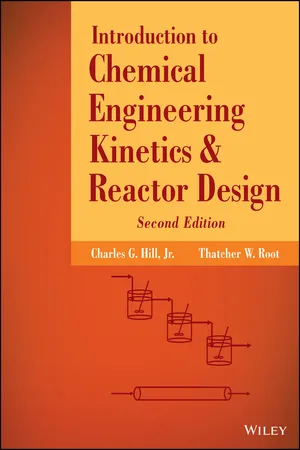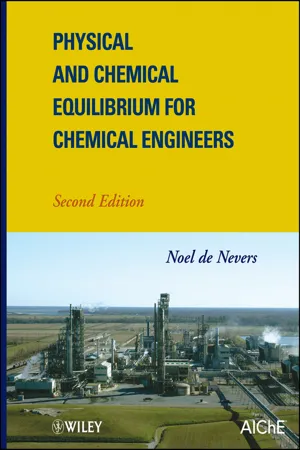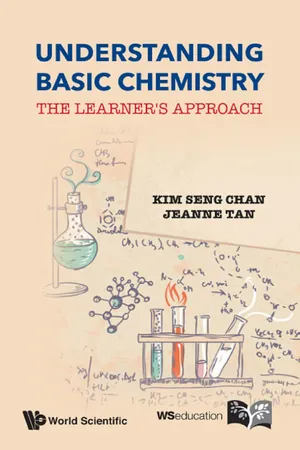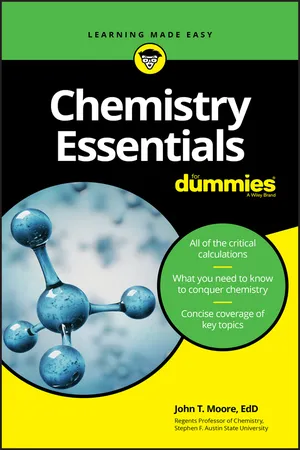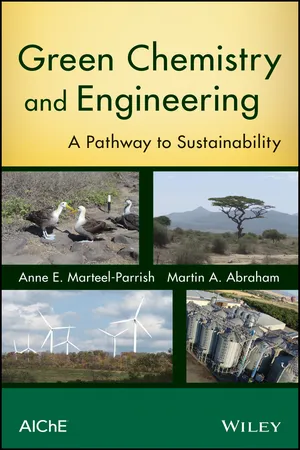Chemistry
Reversible Reaction
A reversible reaction is a chemical reaction that can proceed in both the forward and reverse directions. This means that the products of the reaction can react with each other to reform the original reactants. In a reversible reaction, the system reaches a state of dynamic equilibrium where the rates of the forward and reverse reactions are equal.
Written by Perlego with AI-assistance
Related key terms
Related key terms
1 of 4
Related key terms
1 of 3
7 Key excerpts on "Reversible Reaction"
- Charles G. Hill, Thatcher W. Root(Authors)
- 2014(Publication Date)
- Wiley(Publisher)
Chapter 5 Chemical Systems Involving Multiple Reactions5.0 Introduction
The chemical compositions of many reacting systems can be expressed in terms of a single reaction progress variable. However, a chemical engineer must often consider systems that cannot be adequately described in terms of a single extent of reaction. In this chapter we are concerned with the development of the mathematical relationships that govern the behavior of such systems. We treat Reversible Reactions, competitive (parallel) reactions, and consecutive reactions, first in terms of the mathematical relations that govern the behavior of such systems and then in terms of the techniques that may be used to relate the kinetic parameters of the system to the phenomena observed in the laboratory.5.1 Reversible Reactions
Reversible Reactions are those in which appreciable quantities of all reactant and product species coexist at equilibrium. For these reactions the rate that is observed in the laboratory is a reflection of the interaction between the rate at which reactant species are transformed into product molecules and the rate of the reverse transformation. The ultimate composition of the systems in which such reactions occur is dictated not by exhaustion of the limiting reagent but by the constraints imposed by the thermodynamics of the reaction.5.1.1 Mathematical Characterization of Simple Reversible Reaction Systems
The time dependence of the composition of a system in which a Reversible Reaction is occurring is governed by the mathematical forms of the rate expressions for the forward and reverse reactions, the net rate of reaction being the difference between these two quantities:5.1.1In this section we discuss the mathematical forms of the integrated rate expression for a few simple combinations of the component rate expressions. The discussion is limited to reactions that occur isothermally in constant density systems, because this simplifies the mathematics and permits one to focus on the basic principles involved. Again we place a “V” to the right of certain equation numbers to emphasize that such equations are not general but are restricted to constant volume batch reactors. The use of the extent per unit volume in a constant volume system (- eBook - ePub
- Jeffrey Gaffney, Nancy Marley(Authors)
- 2017(Publication Date)
- Elsevier(Publisher)
Reversible Reaction is a chemical reaction where the reactants first form products, which then react together to give back the reactants. Most of all chemical reactions are reversible to some extent even if the back reaction is very slow and the concentrations of the reformed reactants are very small. The reversible chemical reaction is represented in a chemical equation by the presence of a double arrow (⇄) between the reactants and products. The double arrow indicates that the reaction can go in both directions and both products and reactants are present in the reaction system at the same time. In the generic Reversible Reaction;a A + b B ⇄ c C + d D(3)the reactants A and B can react to form the products C and D and the products C and D can also react to reform the original reactants A and B. The reaction that proceeds from left to right, forming products C and D, is known as the forward reaction, while the reaction that proceeds from right to left reforming the original reactants A and B is known as the reverse reaction . Even though reversible chemical reactions occur in both directions, the chemical species designated as products and reactants are determined by the forward reaction. So, the species on the left side of the chemical equation are the reactants and the species on the right side of the chemical equation are the products of the reaction.As previously described in Section 5.1 , weak acids and bases undergo Reversible Reactions. A weak Brønsted-Lowry acid (HAw ) partially ionizes in water to form the hydronium ion and the conjugate base (A− ), which can then react to reform the weak acid and water.HA waq +H 2O l ⇄H 3O +aq +A −aqThe hydronium ion, the conjugate base, and the molecular form of the weak acid all exist in solution at the same time. So, both the forward reaction, ionization of the weak acid, and the reverse reaction, reformation of the weak acid, occur in the solution simultaneously.As shown in Fig. 7.2 , when the reactants of a Reversible Reaction are first combined, the forward reaction occurs rapidly increasing the concentrations of the products and decreasing the concentrations of the reactants. As the reaction proceeds and the concentration of products increases, the forward reaction slows and the reverse reaction begins to occur. After some time, an equilibrium is reached where the concentrations of reactants and products do not change with time and the forward and reverse reaction rates are equal. This is known as a dynamic equilibrium - eBook - ePub
Enzyme Kinetics: Catalysis and Control
A Reference of Theory and Best-Practice Methods
- Daniel L. Purich(Author)
- 2010(Publication Date)
- Elsevier(Publisher)
Suppose for the sake of argument, we say that there is an alternative path in which A passes through an intermediate form X on its way to C. This situation could be schematically drawn as follows:where the subscripts on each rate constant indicate the direction of the reaction. One may ponder whether this cyclic scheme can provide a pathway to maintain A and B in equilibrium through the intermediate X. In fact, however, such a mechanism would violate the Detailed Balancing Principle, because at equilibrium the rate of any particular reaction step must be exactly equal to (i.e ., must be exactly balanced by) the rate of the reverse of that reaction step.Note : The significance of the Principle of Microscopic Reversibility is that once a mechanism is established for the forward reaction direction, the mechanism of the reverse process must occur in an exact reverse-order manner. The implication for the systematic investigation of enzyme mechanism is equally profound: if an intermediate is exclusively formed in the forward direction, then the same intermediate must operate in the mechanism for the reverse direction. Further, if an acid or base group plays a required catalytic role in the forward direction, so too must that group play the same essential catalytic role in the reverse direction.For the case presented earlier, we considered collections of molecules on a large or macroscopic scale. If we consider the same process on the molecular scale, the corresponding rule is known as the Principle of Microscopic Reversibility . This principle, which is deeply rooted in classical equilibrium thermodynamics, is equally well grounded in statistical and quantum mechanics. Chemical reactivity depends on the position and momenta of the atoms comprising a reacting molecular configuration. The probability that any particular molecular configuration occurs only depends on the energy of that configuration, not the direction of the velocity vectors associated with such atoms. Although this condition can be rigorously proven by quantum mechanics as transition probabilities, its reasonableness is also supported by classical transition state theory: molecules following any given path between reactant and product will naturally pass over the lowest potential energy barrier, thus traversing the same path in each direction. It therefore follows that any proposed chemical reaction mechanism that fails to obey the Principle of Detailed Balance (or Microscopic Reversibility - Noel de Nevers(Author)
- 2012(Publication Date)
- Wiley(Publisher)
Chapter 12 Chemical Equilibrium12.1 Introduction to Chemical Reactions and Chemical EquilibriumChemical reactions transform one chemical species or set of species to another species or set of species: reactant(s) → product(s). Sometimes we do this because the products (e.g., pharmaceuticals) are much more valuable than the reactants from which they are made. Sometimes we want the heat released by the chemical reaction of the materials (e.g., fuels) with air (burning) either to heat some material (cooking our food or heating our homes) or to burn the fuels inside the engines that propel our vehicles or generate electricity. Sometimes we destroy harmful materials by chemical reaction (incineration of hazardous hydrocarbons, destruction of bacteria, protozoa, and viruses in drinking water with chlorine or ozone). The most important chemical reactions are those within our bodies. Every second millions of chemical reactions are occurring in our bodies, accomplishing all the things we call life. The chemical reactions in our nervous system control our muscular movements and our thoughts; the nerve gases that interfere with those chemical reactions can kill in seconds.In this chapter we consider only single chemical reactions, all occurring in one phase. In the next chapter we consider multiple reactions, in series and in parallel, occurring in one or more phases. The next chapter introduces no new principles, only more complex and interesting applications of the ideas of this chapter.- eBook - ePub
Understanding Basic Chemistry
The Learner's Approach
- Kim Seng Chan, Jeanne Tan(Authors)
- 2014(Publication Date)
- WSPC(Publisher)
CHAPTER 7EQUILIBRIA, AMMONIA, AND SULFURWhen two moles of hydrogen gas are sparked with one mole of oxygen gas, you get 36 g of water. But when one mole of nitrogen is allowed to react with three moles of hydrogen, you do not get two moles of ammonia. Why? Shouldn’t chemical reactions be completed if you put in stoichio-metric amounts of reactants?It is incorrect to think that all chemical reactions would proceed to completion and all reactions are irreversible. In fact, there are many chemical reactions that are reversible. For such Reversible Reactions, not all the reactants would be converted to the products. At this stage, we would simply have a mixture of unreacted co-existing reactants and products.What then could be used to characterize a Reversible Reaction? How would we know if one system is more reversible than another? What are the factors that affect a Reversible Reaction? Can we modify a Reversible Reaction to optimize the formation of the desired products that manufacturers want? These are the questions that we seek to answer in this chapter.7.1 Reversible ReactionsWhen ammonia (NH3 ) gas comes in contact with hydrochloric acid (HCl) gas, we have the white ammonium chloride (NH4 Cl) formed (Chapter 1 on The Particulate Nature of Matter). But when we heat the ammonium chloride, it decomposes back to ammonia gas and hydro-chloric acid gas.Such reactions that can proceed in two directions, forward and backward, are known as reversible reactions. Equations of Reversible Reactions are represented with a double-headed arrow ( ):The reaction from left to right is known as the forward reaction.The reaction from right to left is known as the backward reaction or reverse reaction.QSo, is there any difference between the two following equations?A:Oh yes! These two equations have different meanings. For Equation (1), it means that when NH3 is mixed with HCl, they react incompletely to form NH4 Cl. On the other hand, Equation (2) means that NH4 Cl decomposes to form NH3 and HCl incompletely. So, in a nutshell, the difference between the two equations is because of different forward and backward reactions. Or in another perspective, the reactants for Equation (1) are NH3 and HCl, while for Equation (2), it is NH4 - eBook - ePub
- John T. Moore(Author)
- 2019(Publication Date)
- For Dummies(Publisher)
Chapter 7Chemical Reactions
IN THIS CHAPTERDifferentiating between reactants and productsFinding out how reactions occurTaking a look at types of reactionsUnderstanding how to balance reactionsFiguring out chemical equilibriumChecking out speeds of reactionIn a chemical reaction, substances (elements and/or compounds) are changed into other substances (compounds and/or elements). You can’t change one element into another element in a chemical reaction — that happens in nuclear reactions, as I describe in Chapter 4 .A number of clues show that a chemical reaction has taken place — something new is visibly produced, a gas is created, heat is given off or taken in, and so on.In this chapter, I discuss chemical reactions — how they occur and how to write a balanced chemical equation. I also tell you about chemical equilibrium and explain why chemists often can’t get the amount of product out of a reaction that they thought they could. And finally, I discuss the speed of reaction.Reactants and Products: Reading Chemical Equations
You create a new substance with chemical reactions. The chemical substances that are eventually changed are called the reactants, and the new substances that are formed are called the products .Chemical equations show the reactants and products, as well as other factors such as energy changes, catalysts, and so on. With these equations, you use an arrow to indicate that a chemical reaction has taken place. Beneath or above this arrow people sometimes indicate that a specific catalyst is used, or acidic conditions or heat is applied, and so on. In general terms, a chemical reaction follows this format:For example, take a look at the reaction that occurs when you light your natural gas range in order to fry your breakfast eggs. Methane (natural gas) reacts with the oxygen in the atmosphere to produce carbon dioxide and water vapor. (If your burner isn’t properly adjusted to give that nice blue flame, you may also get a significant amount of carbon monoxide along with carbon dioxide.) You write the chemical equation that represents this reaction like this: - eBook - ePub
Green Chemistry and Engineering
A Pathway to Sustainability
- Anne E. Marteel-Parrish, Martin A. Abraham(Authors)
- 2013(Publication Date)
- Wiley-AIChE(Publisher)
5
CHEMICAL REACTIONS
5.1 DEFINITION OF CHEMICAL REACTIONS AND BALANCING OF CHEMICAL EQUATIONS
The concept of molecules and compounds was introduced in Chapter 4. Chemists and chemical engineers manipulate compounds to form new materials that achieve a specific goal or purpose. It is of crucial importance that compounds be mixed in the proper ratios so that the desired reaction can be achieved. The relationship between the compound and its atoms is displayed through the molecular formula, and the chemist uses this information to develop a balanced chemical equation that can properly describe the breaking and forming of bonds in chemical reactions.As mentioned in Chapter 4, a chemical reaction is “a process in which substances (reactants) change into other substances (products) by rearrangement, combination, or separation of atoms.” A chemical reaction is represented by a chemical equation with two sides: one for the reactants and one for the products.The arrow means “forms,” “yields,” “changes to,” or “is/are converted into.”The law of conservation of matter, “matter is neither destroyed nor created,” applies to all atoms in a chemical reaction. As a result, a balanced chemical reaction requires that there must be an equivalent number of atoms of each type on both sides of the equation. Consider the reaction between hydrogen and oxygen to form water, as shown in Equation 5.1 .(5.1 )In Equation 5.1 , we have placed a letter in front of each molecule to represent the stoichiometric coefficient, a multiplying number assigned to the species in a chemical equation in order to balance the equation. Now the challenge is to determine what number each letter in Equation 5.1 represents.Let’s suppose we were producing one molecule of water. In this case, there would be one oxygen atom on the right-hand side of the equation, and to have a balanced chemical equation would require that we have one oxygen atom on the left side. But diatomic oxygen is shown on the left side, and it is not possible to have fractional numbers of molecules. So the smallest number of oxygen molecules on the left side would be one. Based on this analysis, let’s tentatively state that m
Index pages curate the most relevant extracts from our library of academic textbooks. They’ve been created using an in-house natural language model (NLM), each adding context and meaning to key research topics.
Explore more topic indexes
Explore more topic indexes
1 of 6
Explore more topic indexes
1 of 4
